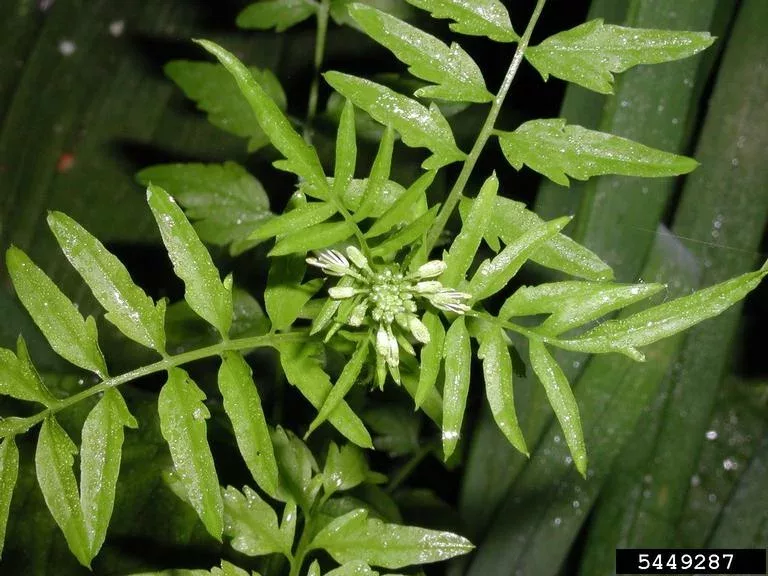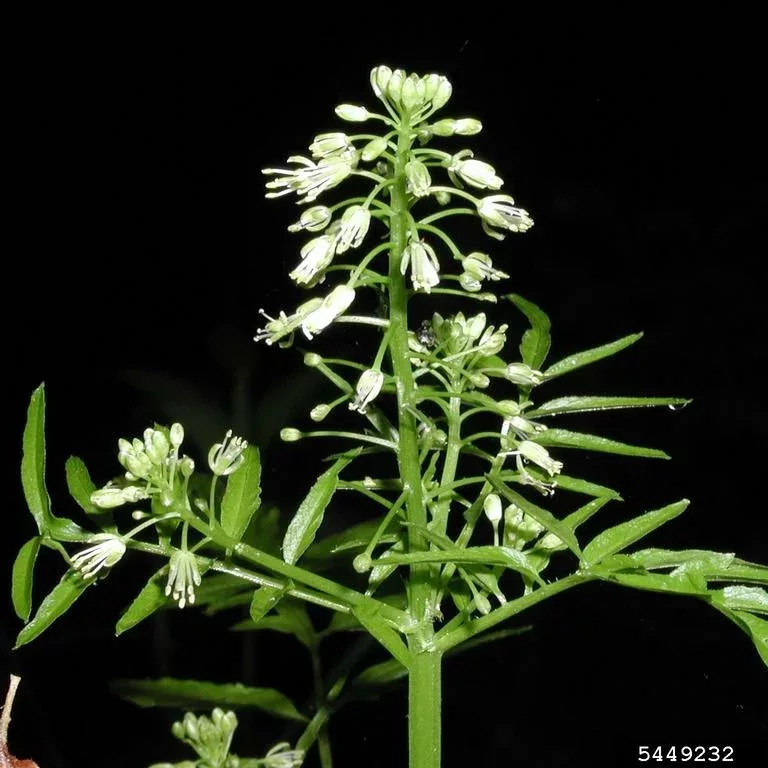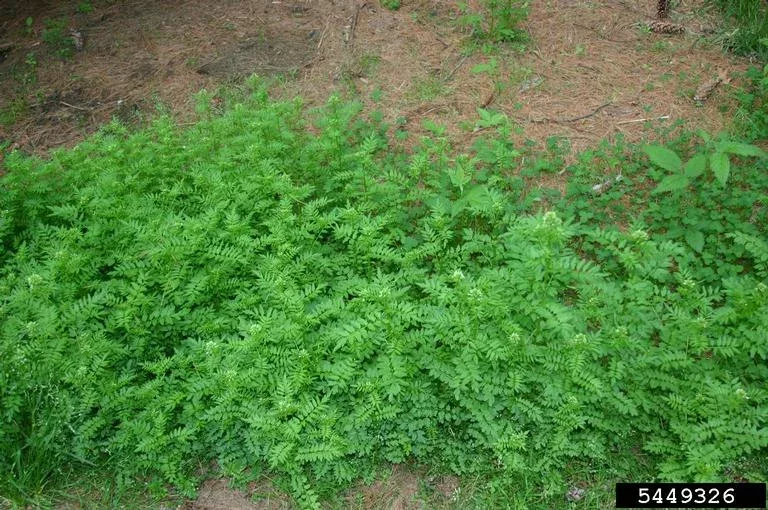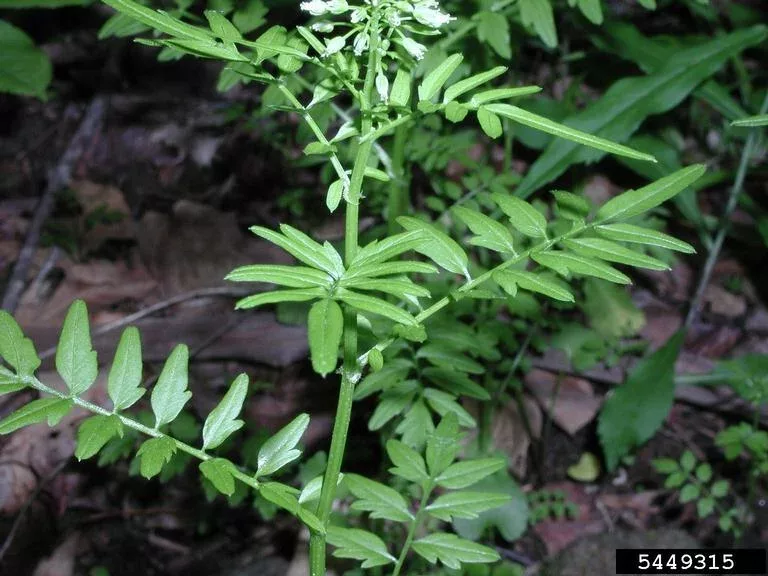
Narrow-leaf bittercress is a member of the Mustard family (Brassicaceae).
An herbaceous annual or biennial growing to two feet in height, narrowleaf bittercress is an inconspicuous denizen of moist soils and dappled shade. The species’ highly divided leaves, on both the basal rosette and along the stem, help distinguish it from the plethora of other members of the same genus present throughout the region. (2)
The species was first recorded in New Hampshire in 1916 and first reported in New Jersey in 2000(10) and is now extant in at least 18 states.(4)

Leaves
Leaves are arranged alternately, pinnately divided, bearing six to nine pointed leaflets. (2)

Flowers
The species’ inconspicuous flowers bloom from April to June(11) in small clusters at the top of a long stem. Individual flowers are small (approximately 0.1 inches across), white, and four petalled. (3)

Fruit/Seed
Seed production occurs from early May through early July(11).

Reproduction and Phenology
As a relatively recent invader in the Northeast, very little is yet known about the reproductive potential of narrowleaf bittercress. The species is a prolific producer of viable seed and is self-fertile: a single plant can quickly become a smothering colony. More germination and seed viability trials and research are needed. (7) Vectors include water, birds, mammals, explosive dehiscence and human recreation. (5)

Narrowleaf bittercress is commonly found on rich, moist soils. The species often establishes around watercourses such as ditches, streams, and on floodplains although it is common in the dappled shade of disturbed woodlands too. It is occasionally present in sunny locations such as forest clearings, or old meadows. (8)

Narrowleaf bittercress is a herbaceous perennial belonging to the mustard family. A prolific producer of seed, this species spreads rapidly into new areas, forming dense stands and displacing native vegetation. Although narrowleaf bittercress is a spring-blooming species and rapidly completes its reproductive cycle, senescing shortly after midsummer, its impacts on spring ephemeral populations may be significant. (3)


Biological Control
There are currently no biological control agents in use against this species.
Manual or Mechanical Control
Pulling / Digging Up: Hand pulling or digging young plants is effective if performed prior to seed set. (6)
Mowing: Cutting prior to seed set helps lessen seed rain in the following season. However, pulling is a more effective method of control if only managing small populations. Larger populations may be weed wacked. (8)
Girdling: Not applicable
Prescribed Fire: No information available
Prescribed Grazing: Although there is anecdotal evidence deer do browse narrowleaf bittercress, no information is available on the utility of grazing as a management tool for this species.
Soil Tilling: Not advisable. The moist, often fragile soils narrowleaf bittercress grows on are vulnerable to erosion. Pulling or weed whacking is a better option.
Mulching: Mulching may help reduce the seed bank and cover bare ground after infestations have been controlled via spraying and or pulling, however, this will also reduce the reestablishment of other, native vegetation in the area, too.
Solarization: Not applicable
Hot Foam Spray: No information available
Chemical Control
The pesticide application rates and usage herein are recommendations based on research and interviews with land managers. When considering the use of pesticides, it is your responsibility to fully understand the laws, regulations and best practices required to apply pesticides in a responsible manner. At times, the pest you seek to treat may not be on a pesticide label, requiring a 2ee exemption from NYSDEC. Always thoroughly read the label of any pesticide and consult the NYSDEC or a licensed pesticide applicator with questions.
Foliar Spray: A 3% solution of glyphosate or triclopyr is effective at managing narrowleaf bittercress, although repeat spot applications may be necessary. Infestations managed in this way should be revisited in 2-3 weeks to monitor for regrowth. Early spring spraying, before other ephemeral plants have leafed out will provide the greatest management efficacy and the least collateral damage of non-target species. Always read and follow all instructions on the herbicide label.
Cut Stump: Not applicable
Basal Bark: Not applicable
Hack-And-Squirt: Not applicable
Stem Injection: Not applicable
Pre-Emergent Spray: No information available
General management overview and recommendation
As with any other invasive infestation complex, large stands of narrowleaf bittercress are best managed via a combination of mechanical and chemical means. All managed infestations should be monitored for at least several years to monitor for new seedlings and to prevent reinvasion from nearby populations. Any new seedlings can be hand pulled or sprayed. (6)
Post treatment monitoring
Controlled populations should be revisited twice a season for several years.
Disposal Methods
Narrowleaf bittercress can be composted unless the plant has already formed viable seed heads, in which case all reproductive parts must be bagged and disposed of. (9)
Glenn, Steven D., and Kerry Barringer. “Cardamine Impatiens L. (Brassicaceae) in New Jersey.” The Journal of the Torrey Botanical Society, vol. 131, no. 3, 2004, pp. 257–260. JSTOR, JSTOR, www.jstor.org/stable/4126956.
